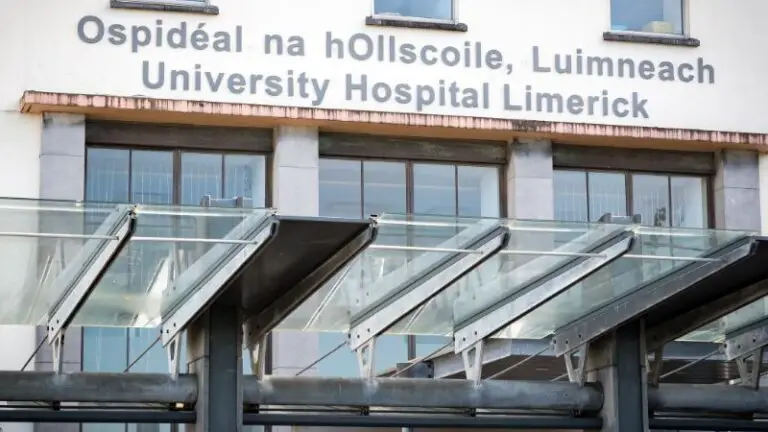MAJOR CONCERNS surrounding patient safety at University Hospital Limerick (UHL) have been flagged in a new report by the Health Information and Quality Authority (HIQA).
On Friday, HIQA published a report from its unannounced inspection at UHL which took place across seven hours on March 15th of this year, ahead of the double bank holiday weekend at St Patrick’s Day.
As part of the inspection, HIQA inspectors spoke with staff and management to ascertain further detail into the planning, delivery and monitoring of services provided to patients in the emergency department, they observed the delivery of care and interactions with patients, they also reviewed documents to see if appropriate records were kept and that they reflected practice and what people told inspectors.
UHL was found to be partially compliant when it came to leadership, governance and management, a. However HIQA deemed it as non-compliant regarding its workforce, person-centred care and support plus safe and support.
Conditions at UHL are insufficient to meet the needs of patients, the inspection found, which compromise the delivery of safe care. The hospital is failing to comply with national standards governing patient dignity, patient care and staffing levels while UHL is only partially compliant with guidelines for the effective management of services.
Inspectors were not assured that UHL had adequate measures in place to address overcrowding, prolonged ED waiting times, ineffective patient flow and insufficient nurse staffing with a 17 percent shortfall in the agreed number of nurses rostered on duty. Measures to try tackle these issues have been ineffective, the report concluded.
Lengthy delays were experienced in the “grossly overcrowded” ED while the inspection took place. One patient had been waiting on a trolley for a total of 116 hours, another 85 hours and one individual spent 71 hours in UHL without treatment. 50 people were lying on trolleys around the overcrowded department posing “severe difficulties” and leaving patients with “little to no privacy or dignity”.
More than 20 percent of the patients at UHL were there for over 24 hours while 28 people in the ED were aged over 75, none of them were admitted or discharged within nine hours of registration, which was not in line with the national target of 99% of patients aged 75 years and over being admitted to a hospital bed or discharged within nine hours of registration.
On the day in question, a total of 290 people attended the facility. The report said hospital management have cited overall bed capacity in UHL, and across the wider Mid-West, as a major contributory factor to the ED overcrowding. But it said the recent addition of 98 new inpatient beds has had no major impact on easing pressure in the ED.
In 2020, the re-attendance rate to the hospital’s emergency department was 4.5% which was below the national target of 8.1%. The average number of patients who left the hospital’s emergency department in 2019 before completing their care was 4.3%, which was below the national target of 6.5% for that year.
Performance data on the patient experience time collected on the day of HIQA’s inspection was poor. The data showed that at 11.30am the hospital was not compliant with any of the national key performance indicators for the emergency department set by the HSE. 76 (55%) attendees to the emergency department were in the department for more than six hours after registration. This was not in line with the national target which requires that 70% of attendees are admitted to a hospital bed or discharged within six hours of registration.
Over half (51%) of the attendees to the emergency department were in the department for more than nine hours after registration. This figure falls short of the national target of 85% of attendees being admitted to a hospital bed or discharged within this time frame. Just over one in five (21%) attendees to the emergency department were in the department for more than 24 hours after registration. The department fell significantly outside the national target which aims for 97% of patients to be admitted to a hospital bed or discharged within 24 hours of registration.
“Persistent overcrowding” heightened the risk of infection, the inspectors flagged. The visit coincided with a time when there was a surge of COVID-19 cases.
Kind and caring staff were working in UHL, the report acknowledged with patients speaking highly of the manner in which they dealt with them.
The issue of overcrowding in the hospital’s emergency department has been persistent over the past number of years with the department experiencing unprecedented levels of attendance since January 2022. In 2021, the emergency department at the hospital had the second highest rate of attendance in Ireland. In that year, 76,473 people attended the hospital’s emergency department compared to 65,824 attendees in 2020, which represented an increase of 7.2% attendees on the previous year. This equated to an average attendance rate to the department of 226 people per day. By comparison, other Model 4 hospitals in Dublin had an emergency department attendance of between 48,397 and 89,335 and rates of attendance were generally stable in 2021.
While being the second busiest emergency department in 2021, the hospital has the second lowest bed stock compared to other Model 4 hospitals in Dublin, Cork and Galway.
In response to the inspection, the HSE submitted a compliance plan to HIQA. UHL said nursing staff have been redeployed to the ED since the inspection. In the short term, it pointed to the reviews being conducted, to try and address the multiple issues raised. In addition, there are plans to use more beds on the St John’s Hospital site in Limerick; Patients will be transferred to other hospitals in the region, after being reviewed in the ED; and eight beds in Nenagh will re-open by the end of this month.
In the longer term, the HSE said it is progressing plans for an extra 96 beds in Limerick and that ongoing efforts are underway to recruit and secure funding for additional consultant and non-consultant posts at UHL. The HSE said it will also explore the provision of a Model 3 hospital in the region, to support activities undertaken in UHL.
UHL has the only emergency department in the Mid-West providing a 24/7 service for a catchment of approximately 385,172 people. The region also has three local injury units located in St John’s Hospital, Ennis General Hospital and Nenagh General Hospital that provides treatment for a smaller number of people with minor injuries unlikely to need admission to hospital.
Commenting on the publication of the HIQA Report, Prof Brian Lenehan, Chief Clinical Director, UL Hospitals Group, said, “We acknowledge that the measures in our escalation plan are not sufficient to meet the unprecedented increase in demand on our service. This is not for want of effort or commitment on the part of management and staff. While we are committed to taking the actions we can to bring about improvement, we hope that publication of this report today results in a wider acknowledgement that many of the solutions to this persistent problem in Limerick are to be found outside of the Emergency Department and outside of the hospital”.
Prof Lenehan added, “The MidWest and UHL has many unique challenges. We have fewer inpatient beds and fewer consultants and NCHDs to provide care than comparable hospitals. We serve a region with a higher frailty index and a city with a higher deprivation index. Over the course of the pandemic, our ED did not see the scale of reduction in presentations seen around the country and the growth in demand on our hospital since has also been disproportionate and exceptional. The volume of self-referrals to our ED as outlined in the HIQA report is higher than elsewhere. People of the MidWest have fewer alternatives than elsewhere when it comes to accessing emergency care. We look forward to the fulfilment of the promise of Slaintecare that healthcare resources will be distributed more equitably in future in line with population need. The case for an acceleration of Slaintecare in the MidWest is obvious”.
He concluded, “I would like to apologise to each and every patient who faces excessive wait times in our ED. It is essential that people who need it continue to attend our Emergency Department. We are committed to working with all stakeholders on improving our processes and how we work to meet this challenge. We acknowledge the significant investment we have received in recent years in improving our infrastructure. Lack of bed capacity remains our primary constraint and we hope that publication of this report today redoubles the efforts of all to ensure that the MidWest catches up with the rest of the country in terms of bed numbers and staffing resources”.
A spokesperson for UL Hospitals Group flagged that the CEO of the Group, Colette Cowan has commissioned Deloitte to conduct an external review of patient flow at University Hospital Limerick. This review is intended to provide an independent and comprehensive overview of patient flow through the ED at UHL while at the same time looking at the use of resources, processes in place and identifying any constraints. Our community and GP colleagues in the MidWest are also being consulted as part of this review and the final report from Deloitte is expected in the coming weeks.











